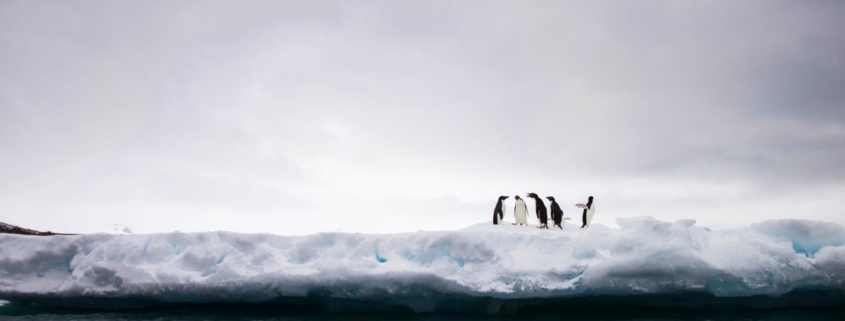Antarctic sea ice has been at record low levels for months — here’s what that means
Antarctic sea ice has been at record low levels for the past few months. That’s not a great sign for the planet, which has been reaching record high temperatures within the last week, but it’s also not as bad as the decades-long melting happening in the Arctic.
Tracking sea ice, which is the frozen seawater that floats on the ocean surface near the poles, is one of the ways climate scientists measure how the planet is warming.
“Sea ice is sensitive to warming temperatures — a small change from just below to just above freezing temperatures is the difference between ice and ocean. So, it is an early indicator of change in the environment,” Walt Meier, senior research scientist at the National Snow and Ice Data Center at the University of Colorado, told CNBC.
The two poles of the earth are themselves warming at a faster pace than any other part of the planet, Howard Diamond, the climate science program manager at the U.S. National Oceanic Atmospheric Administration’s Air Resources Laboratory, told CNBC.
“The poles are warming at a greater rate of changethan anywhere else on the planet, but the equator is still the warmest region of the planet, and while it continues to warm along with the rest of the planet, itsrate of change is less than that of the poles,” Diamond told CNBC
What the record low sea ice in the Antarctic means
Antarctica, which encompasses the South Pole, is a land mass covered in ice, surrounded by sea ice and the Southern Ocean.
On February 21, sea ice in the Antarctic set a record low for the second year in a row, going back to 1979, which is as far back as the records go at the National Snow and Ice Data Center.
Ever since then, the amount of sea ice continues to track at record low levels.
“We’ve had three record low summers in the last few years (2016/17, 2022 and 2023), plus the current winter growth season is unlike anything we’ve seen in our 45 years of continuous satellite observations,” Will Hobbs, a physical oceanographer and sea ice project co-lead for the Australian Antarctic Program Partnership, told CNBC. “That’s a very sudden shift, since up to 2015 the Antarctic is cover was increasing, not decreasing like the Arctic.”
Because the downturn in Antarctic sea ice is new, it’s too soon to know exactly why this is happening, according to scientists who study the flows of sea ice at the poles.
“As for the question ‘is this climate change?’, the science community probably isn’t ready to state that yet,” Hobbs told CNBC. It’s “the million dollar question,” Hobbs said, and answering it “will keep us busy for a few years yet.”
That being said, it’s not good news.
“What we can say for certain is that this kind of collapse was predicted, albeit not for a few decades, so the best case scenario is that we’re getting a glimpse of Antarctica’s future,” Hobbs told CNBC. ’The worst case is that the ice doesn’t recover, and the future came a few decades earlier than we hoped and expected.”
Because sea ice floating, it doesn’t directly cause sea level rise, Hobbs told CNBC. Think about ice cubes melting in a glass of water.
But sea ice levels do impact sea level rise indirectly. “Antarctic ice sheets, which could cause huge sea level rise, are held back from slipping into the ocean by floating ice shelves, and those are melting,” Hobbs told CNBC. “Sea ice protects those ice shelves from being flexed and cracked by ocean swells, and also is a ‘shade’ that stops the water in front of those ice shelves from warming by summer sunlight.”
Why the sea ice levels in the Arctic are more damning
The Arctic is an ocean covered by a layer of sea ice and surrounded by land. The amount of sea ice in the Arctic in June was the thirteenth lowest on record, according to data from the National Snow and Ice Data Center.
“While the Antarctic is more extreme at the moment, the Arctic has been more extreme for a long time. As I said, the Antarctic had a record high extent as recently as 2014, the year for the record high extent in the Arctic was in 1979, the very first year of the record,” Meier told CNBC.
And then there’s the land ice
In addition to sea ice, the poles both have pretty massive amounts of ice on land.
Annual land ice loss in the Arctic since 2002 has been 276 billion tons per year versus146 billion tons per year in Antarctica, Diamond of NOAA told CNBC. “They are both in the same downward direction,” he said.
While the sea ice does not directly contribute to sea level rise, melting land ice does.
“The melting of these ice sheets is accelerating rapidly, at the moment they lose about 400 billion tons of ice every year. This is enough ice to cover all of New York City by about 1,000 feet of ice — and that’s just the ice loss of one year,” Dirk Notz, professor of oceanography at the Universität Hamburg in Germany with a specialty in sea ice, told CNBC.
The melting land ice in some parts of the Antarctic ice sheet may be inching closer to a “tipping point,” Notz told CNBC.
“With just a little bit of additional warming, the loss of parts of the ice sheet might become unstoppable over many centuries or millennia to come — even if we managed to cool the climate again. This is because some processes within the ice sheet then become self accelerating, and more and more independent of the warming that triggered the initial ice loss,” Notz said.

- https://www.cnbc.com / CNBC
- Published Tue, Jul 11 2023
- By Catherine Clifford
- @in/catclifford/
- @CatClifford




Leave a Reply
Want to join the discussion?Feel free to contribute!